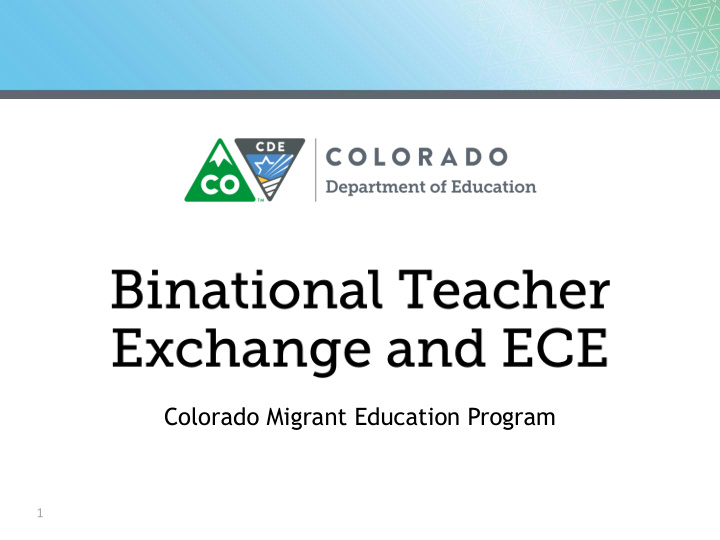



Colorado Migrant Education Program 1
• Understand the instructional implications that are unique to binational students • Share effective practices and strategies for the binational student • Learn about the curriculum and instructional resources to provide services to binational students 2
Who is the binational student? What characteristics of the binational student makes him/her different from other migrant students? What research-based effective practices and strategies can be adapted for the binational student? What are examples of effective practices? What unique strategies and practices do you use with your binational students? What resources and materials are available? 3
• A binational student is a migrant student who has moved between Mexico and the United States with his/her parents or as an emancipated youth at least once in the last 36 months. • The definition in Mexico is the same except that they do not have to be migrant. 4
• Binational students’ lifestyle is characterized by frequent international border crossings and continuous educational interruptions. • Differences between U.S. and Mexico school systems cause a greater need for communication and intense professional development to address binational students. 5
• Typically, binational students suffer the experience of socio-cultural shock, and the lack of identity on both sides of the border, weakening the desire to stay in school. • Binational students may not receive adequate educational assistance from school staff due to the different requirements in Mexico and the U.S. 6
Concern – educational disruption due to frequent border crossings • Network between U.S. and Mexico educators regarding records, schedules, credits, special education issues, promotion and graduation requirements – PROBEM & MEP directories. • Utilize the Binational Transfer Document to expedite enrollment – training & distribution. • Design systems to send books, assignments and other course requirements with departing students. • Utilize correspondence courses and distance learning. 7
Concern – age/grade discrepancy due to educational interruption, differences in educational standards, curriculum, and language of instruction • Ensure acceptance of credits from “sending” school/ country. • Utilize tutorial, computer labs, distance learning, correspondence courses, and summer programs to complete credits. • Facilitate binational student enrollment in ESL classes as needed. 8
Concern – loss of semester credits due to missing final exams because of binational moves • Facilitate early administration of final exams and end of course requirements. • Arrange for exams to be proctored by receiving school/country. • Administer exams and grant credits upon the binational student’s return . • Design and administer alternative assessments prior to withdrawal. 9
Concern - social/cultural identity shock resulting in a lack of sense of belonging Establish a student welcoming committee, buddy • system, peer mentoring, etc. • Assign a teacher, counselor, or MEP staff to mentor newly enrolled binational students. • Involve binational students in extracurricular activities such as multicultural clubs, sports, etc. • Incorporate history and culture of binational students in class-room lessons and school activities. • Involve binational exchange teachers with binational students. 10
Concern - inadequate educational assistance from families and school staff due to different requirements in Mexico and the U.S. • Offer workshops for educators, parents, and students on academic requirements in the U.S. and Mexico. • Encourage educator exchanges between the U.S. and Mexico. • Provide families with concrete tools to support their children’s education. • Facilitate parent/teacher conferences. • Provide family literacy activities. 11
Each classroom is decorated Cada salón de clase es decorado con mucho with lots of color. Its walls are colorido. Sus paredes son covered with materials that tapizadas con materiales que remind students of behavior recuerdan a los alumnos expectations, habits of the maneras de comportarse, mind, learning contents, hábitos de la mente, positive messages, images of contenidos de aprendizaje, topics addressed, mensajes positivos, imágenes reinforcement of values, etc. de temas abordados, refuerzo de valores, etc. 12
13
What is the best season: Cuál es la mejor estación: Summer or Winter ? Verano o Invierno ? 14
Cual es la mejor comida? What is the best food? 15
Se elaboró material para: Classroom Materials: • Reconocimiento de las • Letter/sound recognition vocales y los sonidos. • Alphabet knowledge • Reconocimiento del • Colors abecedario y los sonidos. • Food items/fruits • Los colores. • Las frutas. • Memory games to learn vowel sounds • Memorama de las vocales. • Letter tracing/ writing • Plantillas de las vocales para practicar la escritura. practice 16
• Juegos • Games • Rondas • Rounds • Visualización de videos • Videos • Exposición de el rincón • Creation of “Mexican mexicano Culture” display 17
18
19
20
Colorado Binational Initiative https://www.cde.state.co.us/migrant/binational-initiative-resources US Binational Migrant Education Initiative (BMEI) https://www2.ed.gov/admins/tchrqual/learn/binational.html Early Learning Standards Resources https://www.cde.state.co.us/early/preschoolstandardsresources The Mexican Secretariat of Education has created materials that align with Mexican standards for grades K-9. The materials are available on the following Spanish-language websites, which contain games and activities for students of all ages. SePiensa – http://www.sepiensa.org.mx EduSat -- http://dgtve.sep.gob.mx Red Escolar -- http://redescolar.ilce.edu.mx 21
Tomas Mejia State Director Colorado Migrant Education Program mejia_t@cde.state.co.us Noemi Aguilar Principal Consultant aguilar_n@cde.state.co.us 22
Recommend
More recommend